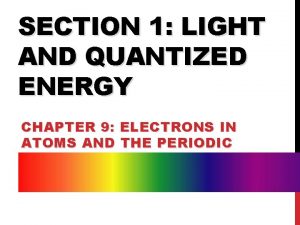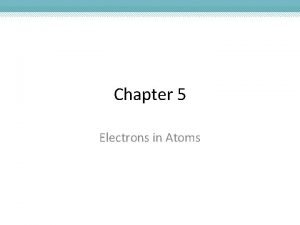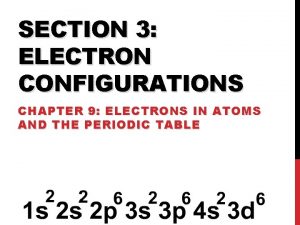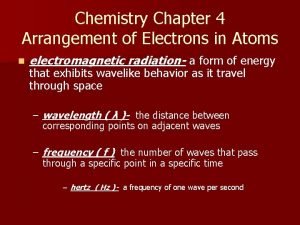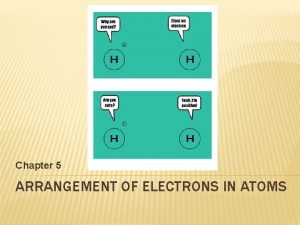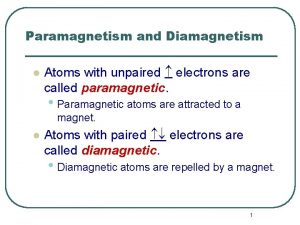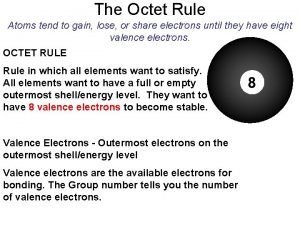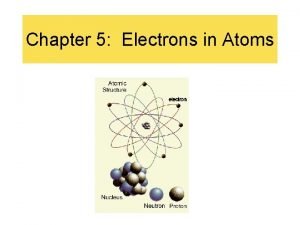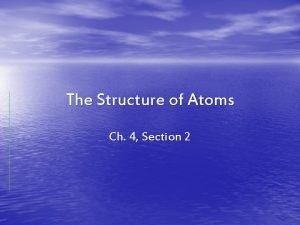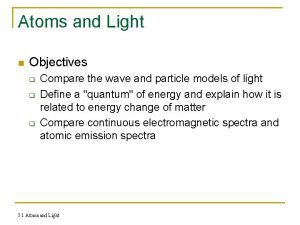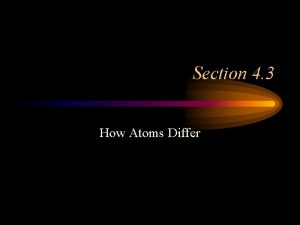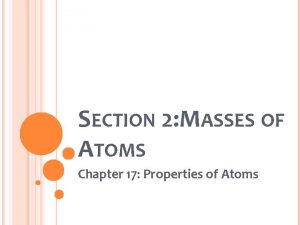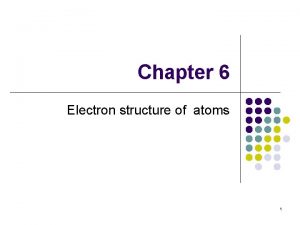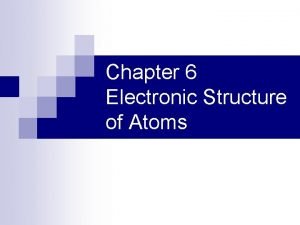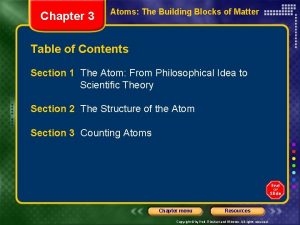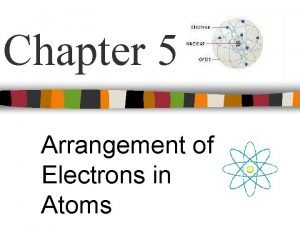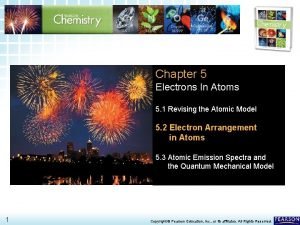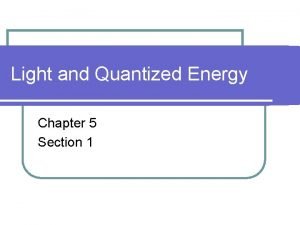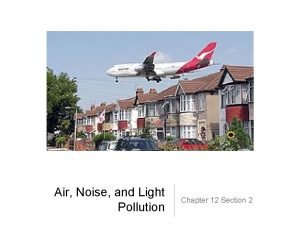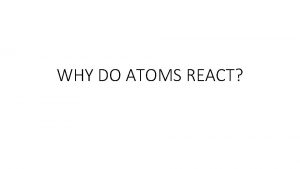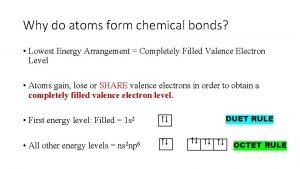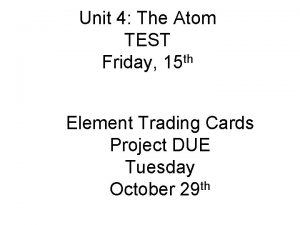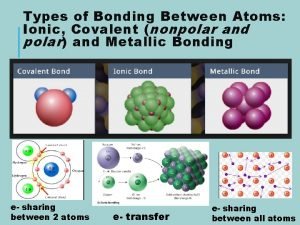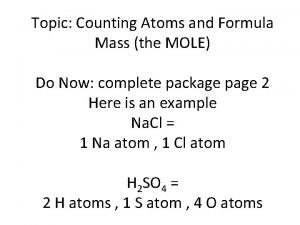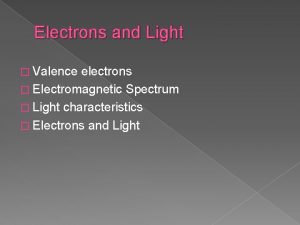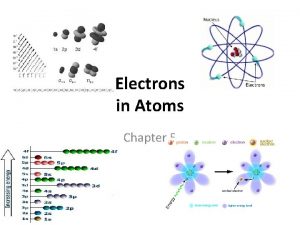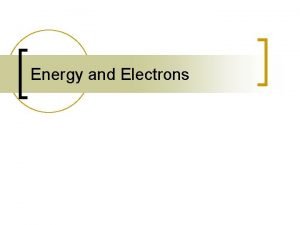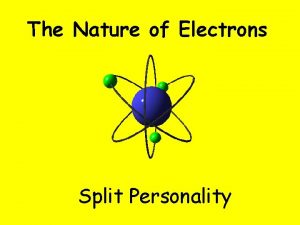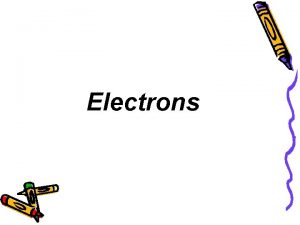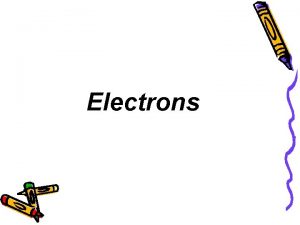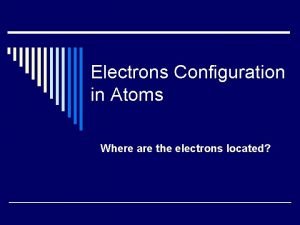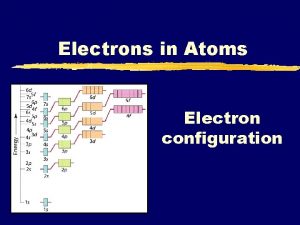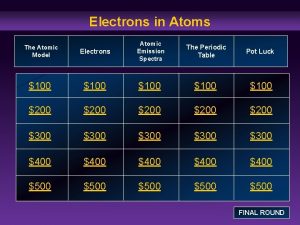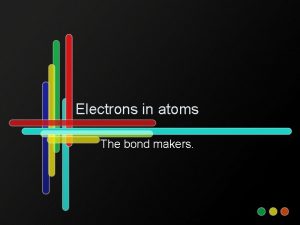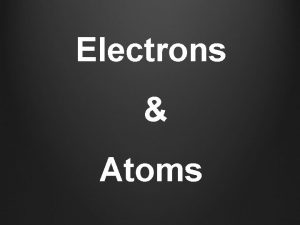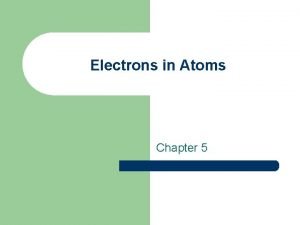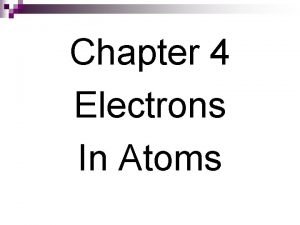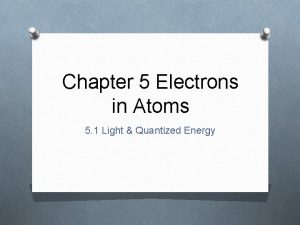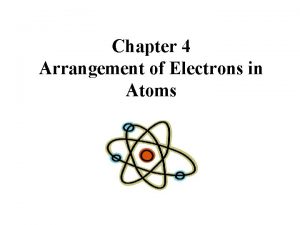Chapter 5 Electrons in Atoms Section 1 Light





















































- Slides: 53

Chapter 5 Electrons in Atoms

Section 1 Light and Quantized Energy

Section 1: Light and Quantized Energy Light, a form of electromagnetic radiation, has characteristics of both a wave and a particle. K What I Know W What I Want to Find Out L What I Learned

The Atom and Unanswered Questions • Recall that in _______model, the atom’s mass is concentrated in the nucleus and electrons move around it. – The model doesn’t explain how the electrons were arranged around the nucleus. – The model doesn’t explain why negatively charged electrons aren’t pulled into the positively charged nucleus. • In the early 1900 s, scientists observed certain elements emitted visible light when heated in a flame. • Analysis of the emitted light revealed that an element’s chemical behavior is related to the arrangement of the electrons in its atoms. Light and Quantized Energy

The Wave Nature of Light • Visible light is a type of _____________, a form of energy that exhibits wave-like behavior as it travels through space. • All waves can be described by several characteristics. • The ______(λ) is the shortest distance between equivalent points on a continuous wave. • The frequency (_) is the number of waves that pass a given point per second. • The ______is the wave’s height from the origin to a crest. Light and Quantized Energy

The Wave Nature of Light • The speed of light (________) is the product of it’s wavelength and frequency c = λν. Light and Quantized Energy

The Wave Nature of Light • Sunlight contains a continuous range of wavelengths and frequencies. • A prism separates sunlight into a continuous spectrum of colors. • The _____________includes all forms of electromagnetic radiation. Light and Quantized Energy

Properties of Waves • Wave length: – The length of each wave - _________ Constant: speed of light (c) 3. 00 × 108 m/s Frequency (v) Hz Wavelength (λ) m

Calculations Microwaves are used to cook food and transmit information. What is the wavelength of a microwave that has a frequency of 3. 44 × 109 Hz? KNOWN UNKNOWN ν = 3. 44 × 109 Hz c = 3. 00 × 108 m/s λ=? m

Calculations • What is the frequency of a microwave that has a wavelength of 6. 72 × 10 -9 m? KNOWN UNKNOWN λ= ν= c=

The Particle Nature of Light • The wave model of light cannot explain all of light’s characteristics. Some examples include: – Why heated objects emit only certain frequencies of light at a given temperature. – Why some metals emit electrons when light of a specific frequency shines on them. Light and Quantized Energy

The Particle Nature of Light The Quantum Concept • In 1900, German physicist Max Planck (1858 -1947) began searching for an explanation of this phenomenon as he studied the light emitted by heated objects. • Planck’s study led him to a startling conclusion: – Matter can gain or lose _______only in small, specific amounts called ____. – A quantum is the _____amount of energy that can be gained or lost by an atom. – Planck’s constant has a value of _______________ Light and Quantized Energy

The Particle Nature of Light The Photoelectric Effect • The ___________is when electrons are emitted from a metal’s surface when light of a certain frequency shines on it. Light and Quantized Energy

The Particle Nature of Light’s Dual Nature • Albert Einstein proposed in 1905 that light has a dual nature. – A beam of light has wavelike and particle-like properties. – A _____is a particle of electromagnetic radiation with no mass that carries a quantum of energy. Light and Quantized Energy

Energy of a Photon - ____________ Ephoton energy Frequency (v) Hz H (Planck’s contstant) 6. 626 × 10– 34 J ● s.

Calculations Every object gets its color by reflecting a certain portion of incident light. The color is determined by the wavelength of the reflected photons, thus by their energy. What is the energy of a photon from the violet portion of the Sun’s light if it has a frequency of 7. 230 × 1014 s-1? KNOWN UNKNOWN ν = 7. 230 × 1014 s-1 Ephoton = ? J h = 6. 626 × 10 -34 J • s

Atomic Emission Spectra • Light in a neon sign is produced when electricity is passed through a tube filled with neon gas and excites the neon atoms. • The excited atoms return to their _____state by emitting light to release energy. Light and Quantized Energy

Atomic Emission Spectra • The atomic _____ spectrum of an element is the set of frequencies of the electromagnetic waves emitted by the atoms of the element. • Each element’s atomic emission spectrum is unique. Light and Quantized Energy

Essential Questions • How do the wave and particle natures of light compare? • How is a quantum of energy related to an energy change of matter? • How do continuous electromagnetic spectra and atomic emission spectra compare and contrast? Light and Quantized Energy

Section 2 Quantum Theory and the Atom

Section 2: Quantum Theory and the Atom Wavelike properties of electrons help relate atomic emission spectra, energy states of atoms, and atomic orbitals. K What I Know W What I Want to Find Out L What I Learned

Bohr’s Model of the Atom • Einstein’s theory of light’s dual nature accounted for several unexplainable phenomena but not why atomic emission spectra of elements were discontinuous rather continuous. • In 1913, Niels Bohr, a Danish physicist working in Rutherford’s laboratory, proposed a quantum model for the hydrogen atom that seemed to answer this question. • Bohr correctly predicted the frequency lines in hydrogen’s atomic emission spectrum. • The lowest allowable energy state of an atom is called its _______. • When an atom gains energy, it is in an _______state. Quantum Theory and the Atom

Bohr’s Model of the Atom • Bohr suggested that an electron moves around the _____only in certain allowed circular orbits. Quantum Theory and the Atom

Bohr’s Model of the Atom • Each orbit was given a number, called the _________ number. • Hydrogen’s single electron is in the n = 1 orbit in the ground state. • When energy is added, the electron moves to the n = 2 orbit. Quantum Theory and the Atom

Atomic orbitals • ______is a region of space around the nucleus where an electron is likely to be found. • An electron cloud is a good approximation of how electrons behave in their orbitals • The level in which an electron has the least energy—the lowest energy level—has only one orbital. Higher energy levels have more than one orbital

Electron Configuration Energy Levels, Orbitals, and Electrons • The most stable Energy Level electron configuration is ___ the one in which the electrons are 2 in orbitals with the 3 lowest possible energies. 4 Number of Orbitals 1 Max. # of Electrons ____ 8 9 _____ 32 2

DRAWING BOHR MODELS OF ATOMS • Draw the nucleus and label with #p & #n • Draw electron orbitals – 1 st orbital can have ____ electrons only – 2 nd and 3 rd ring can each have _____electrons – Fill – _____________ – Inner rings must be filled first before any electron enters a higher ring!!!!! – Let’s Practice:

Bohr Model - Hydrogen

Bohr Model - Oxygen

Bohr Model - Sulfur

Bohr’s Model of the Atom The limits of Bohr’s model • Bohr’s model explained the hydrogen’s spectral lines, but failed to explain any other element’s lines. • The behavior of electrons is still not fully understood, but substantial evidence indicates they do not move around the nucleus in circular orbits. Quantum Theory and the Atom

The Quantum Mechanical Model of the Atom • Heisenberg showed it is impossible to take any measurement of an object without disturbing it. • The _______ uncertainty principle states that it is fundamentally impossible to know precisely both the velocity and position of a particle at the same time. • The only quantity that can be known is the probability for an electron to occupy a certain region around the nucleus. Quantum Theory and the Atom

The Quantum Mechanical Model of the Atom • Schrödinger treated electrons as waves in a model called the quantum ________ model of the atom. • Schrödinger’s equation applied equally well to elements other than hydrogen. • The wave function predicts a three-dimensional region around the nucleus called the _______. Quantum Theory and the Atom

Hydrogen Atomic Orbitals • Principal _____ number (__) indicates the relative size and energy of atomic orbitals. • n specifies the atom’s major energy levels, called the _____ energy levels. • ___________are contained within the principal energy levels. Quantum Theory and the Atom

Hydrogen Atomic Orbitals • Each energy sublevel relates to orbitals of different _______. Quantum Theory and the Atom

Hydrogen Atomic Orbitals Quantum Theory and the Atom

Essential Questions • How do the Bohr and quantum mechanical models of the atom compare? • What is the impact of de Broglie’s wave-particle duality and the Heisenberg uncertainty principle on the current view of electrons in atoms? • What are the relationships among a hydrogen atom’s energy levels, sublevels, and atomic orbitals? Quantum Theory and the Atom

Section 3 Electron Configuration

Section 3: Electron Configuration Three rules are used to determine electron arrangement in an atom. K What I Know W What I Want to Find Out L What I Learned

Ground-State Electron Configuration • The arrangement of electrons in the atom is called the _________________ • The ____ principle states that each electron occupies the lowest energy orbital available. Electron Configuration

Ground-State Electron Configuration

Ground-State Electron Configuration • The aufbau diagram can be used to write correct ground-state electron configurations for all elements up to and including Vanadium, atomic number 23. • The electron configurations for certain transition metals, like chromium and copper, do not follow the aufbau diagram due to increased stability of halffilled and filled sets of s and d orbitals. Electron Configuration

Electron Configuration • _____Configuration - a representation of the arrangement of electrons in an atom

Electron Configuration • Examples of electron Configuration – 1. Li 1 s 22 s 1 – 2. C 1 s 22 p 6 _________ # of e- in that ____

Electron Configuration • Take note that after 4 s is filled, 3 d is than filled before 4 p. • …… 6 s than 4 f than 5 d than 6 p • When writing out the electron configuration, always write your numbers in numerical order – Y 1 s 22 p 63 s 23 p 64 s 23 d 104 p 65 s 24 d 1 – NO! – Y 1 s 22 p 63 s 23 p 63 d 104 s 24 p 64 d 15 s 2

Electron Configuration • Examples: • Be • O • Ca • Mn

Electron Configuration • Examples • Pb • Os

Ground-State Electron Configuration • _____ Rule (better known as the Bus Rule) – Before any second electron can be placed in a sub level, all the orbitals of that sub level must contain at least one electron – spread out the e- before pairing them up. • Pauli _____ Principle - electrons occupying the same orbital must have _______spin. • See a good online illustration at http: //www. avogadro. co. uk/light/aufbau. htm

Orbital Notation H F 1 s 1 s 2 s 2 p

Orbital Notation • Examples: • Li F • Na Sc

Valence Electrons • ____electrons are defined as electrons in the atom’s outermost orbitals—those associated with the atom’s highest principal energy level. • ______structure consists of the element’s symbol representing the nucleus, surrounded by dots representing the element’s valence electrons. Electron Configuration

Significance of Electron Configurations • • Valence shell electrons - _______electrons involved with bonding no atom has more than ____________ Noble gases - ___valence electrons – _____reactive of all elements Lewis Dot structures: NSEW (cheating) also show correct way, count to 8 Lewis Dot Structures

Essential Questions • How are the Pauli exclusion principle, the aufbau principle, and Hund’s rule used to write electron configurations? • How do electron-dot structures represent an atom’s valence electrons? Electron Configuration
 Electrons in atoms section 1 light and quantized energy
Electrons in atoms section 1 light and quantized energy Electrons in atoms section 1 light and quantized energy
Electrons in atoms section 1 light and quantized energy Lowest allowable energy state of an atom
Lowest allowable energy state of an atom Electrons in atoms section 2 quantum theory and the atom
Electrons in atoms section 2 quantum theory and the atom Electrons in atoms section 3 electron configuration
Electrons in atoms section 3 electron configuration Chapter 4 arrangement of electrons in atoms
Chapter 4 arrangement of electrons in atoms Stable electron configurations are likely to contain
Stable electron configurations are likely to contain Chapter 5 review arrangement of electrons in atoms
Chapter 5 review arrangement of electrons in atoms Light light light chapter 23
Light light light chapter 23 Light light light chapter 22
Light light light chapter 22 Light light light chapter 22
Light light light chapter 22 At stp which substance is the best conductor of electricity
At stp which substance is the best conductor of electricity Atoms with 4 valence electrons
Atoms with 4 valence electrons Diamagnetic elements
Diamagnetic elements Proton electron neutron
Proton electron neutron Octet rule
Octet rule How do chemists model the valence electrons of metal atoms?
How do chemists model the valence electrons of metal atoms? Ionic and metallic bonding chapter 7 practice problems
Ionic and metallic bonding chapter 7 practice problems 5 electrons in atoms
5 electrons in atoms Chapter 4 section 2 the structure of atoms
Chapter 4 section 2 the structure of atoms Chapter 6 section 1 atoms elements and compounds answer key
Chapter 6 section 1 atoms elements and compounds answer key Chapter 6 section 1 atoms elements and compounds
Chapter 6 section 1 atoms elements and compounds Electrons and light pogil activity 5-1
Electrons and light pogil activity 5-1 Section 1 atoms elements and compounds
Section 1 atoms elements and compounds Section 3 how atoms differ
Section 3 how atoms differ Section 2 masses of atoms
Section 2 masses of atoms Study guide chapter 10 section 1 meiosis
Study guide chapter 10 section 1 meiosis Chapter 6 electronic structure of atoms answers
Chapter 6 electronic structure of atoms answers Energy quanta
Energy quanta Chapter 3 atoms the building blocks of matter
Chapter 3 atoms the building blocks of matter Which subatomic particle has the least mass
Which subatomic particle has the least mass Chapter 2 atoms molecules and ions
Chapter 2 atoms molecules and ions Put out the light, and then put out the light
Put out the light, and then put out the light Distinguish between photosystem 1 and photosystem 2
Distinguish between photosystem 1 and photosystem 2 The bouncing off of light.
The bouncing off of light. What type of materials can block the path of a light
What type of materials can block the path of a light Chapter 5 arrangement of electrons
Chapter 5 arrangement of electrons Chapter 5 arrangement of electrons
Chapter 5 arrangement of electrons Section 1 light and quantized energy
Section 1 light and quantized energy Light and quantized energy worksheet
Light and quantized energy worksheet Air noise and light pollution
Air noise and light pollution Section 2 air noise and light pollution
Section 2 air noise and light pollution Sectional views reveal
Sectional views reveal Sections
Sections Section view
Section view Section 1 work and machines section 2 describing energy
Section 1 work and machines section 2 describing energy Atoms want
Atoms want Why do atoms form bonds? *
Why do atoms form bonds? * What is the relationship between atoms and elements
What is the relationship between atoms and elements What are atoms?
What are atoms? Kesler science mitosis and meiosis answer key
Kesler science mitosis and meiosis answer key The atoms family atomic math challenge answer key
The atoms family atomic math challenge answer key Electronegativity trend
Electronegativity trend Mass formula
Mass formula
